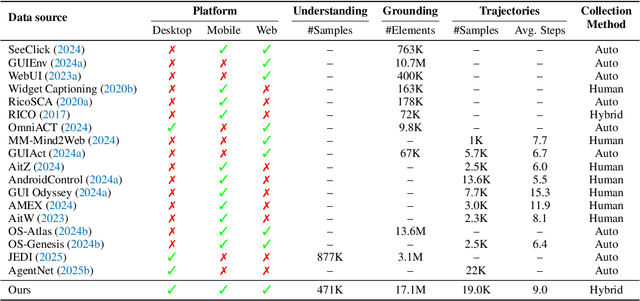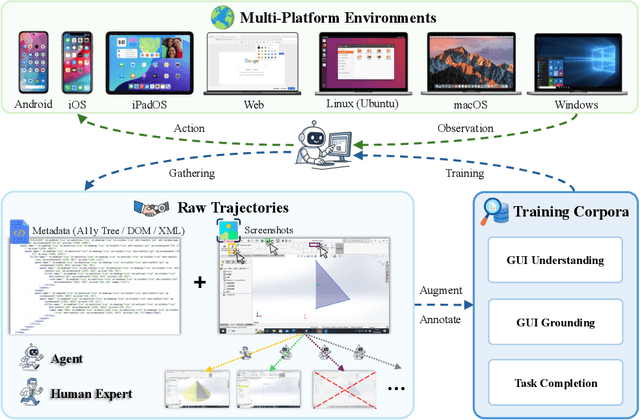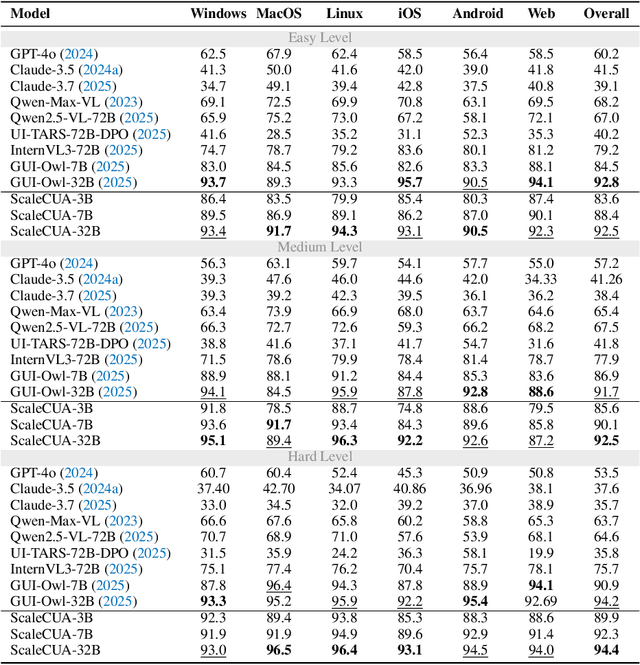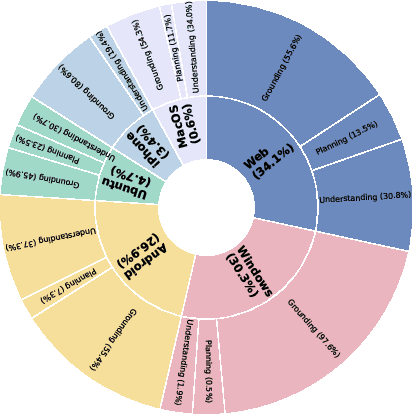Gen Luo
ViCO: A Training Strategy towards Semantic Aware Dynamic High-Resolution
Oct 14, 2025Abstract:Existing Multimodal Large Language Models (MLLMs) suffer from increased inference costs due to the additional vision tokens introduced by image inputs. In this work, we propose Visual Consistency Learning (ViCO), a novel training algorithm that enables the model to represent images of varying semantic complexities using different numbers of vision tokens. The key idea behind our method is to employ multiple MLP connectors, each with a different image compression ratio, to downsample the vision tokens based on the semantic complexity of the image. During training, we minimize the KL divergence between the responses conditioned on different MLP connectors. At inference time, we introduce an image router, termed Visual Resolution Router (ViR), that automatically selects the appropriate compression rate for each image patch. Compared with existing dynamic high-resolution strategies, which adjust the number of visual tokens based on image resolutions, our method dynamically adapts the number of visual tokens according to semantic complexity. Experimental results demonstrate that our method can reduce the number of vision tokens by up to 50% while maintaining the model's perception, reasoning, and OCR capabilities. We hope this work will contribute to the development of more efficient MLLMs. The code and models will be released to facilitate future research.
ScaleCUA: Scaling Open-Source Computer Use Agents with Cross-Platform Data
Sep 18, 2025



Abstract:Vision-Language Models (VLMs) have enabled computer use agents (CUAs) that operate GUIs autonomously, showing great potential, yet progress is limited by the lack of large-scale, open-source computer use data and foundation models. In this work, we introduce ScaleCUA, a step toward scaling open-source CUAs. It offers a large-scale dataset spanning 6 operating systems and 3 task domains, built via a closed-loop pipeline uniting automated agents with human experts. Trained on this scaled-up data, ScaleCUA can operate seamlessly across platforms. Specifically, it delivers strong gains over baselines (+26.6 on WebArena-Lite-v2, +10.7 on ScreenSpot-Pro) and sets new state-of-the-art results (94.4% on MMBench-GUI L1-Hard, 60.6% on OSWorld-G, 47.4% on WebArena-Lite-v2). These findings underscore the power of data-driven scaling for general-purpose computer use agents. We will release data, models, and code to advance future research: https://github.com/OpenGVLab/ScaleCUA.
GenExam: A Multidisciplinary Text-to-Image Exam
Sep 17, 2025Abstract:Exams are a fundamental test of expert-level intelligence and require integrated understanding, reasoning, and generation. Existing exam-style benchmarks mainly focus on understanding and reasoning tasks, and current generation benchmarks emphasize the illustration of world knowledge and visual concepts, neglecting the evaluation of rigorous drawing exams. We introduce GenExam, the first benchmark for multidisciplinary text-to-image exams, featuring 1,000 samples across 10 subjects with exam-style prompts organized under a four-level taxonomy. Each problem is equipped with ground-truth images and fine-grained scoring points to enable a precise evaluation of semantic correctness and visual plausibility. Experiments show that even state-of-the-art models such as GPT-Image-1 and Gemini-2.5-Flash-Image achieve less than 15% strict scores, and most models yield almost 0%, suggesting the great challenge of our benchmark. By framing image generation as an exam, GenExam offers a rigorous assessment of models' ability to integrate knowledge, reasoning, and generation, providing insights on the path to general AGI.
Spotlight Attention: Towards Efficient LLM Generation via Non-linear Hashing-based KV Cache Retrieval
Aug 27, 2025Abstract:Reducing the key-value (KV) cache burden in Large Language Models (LLMs) significantly accelerates inference. Dynamically selecting critical KV caches during decoding helps maintain performance. Existing methods use random linear hashing to identify important tokens, but this approach is inefficient due to the orthogonal distribution of queries and keys within two narrow cones in LLMs. We introduce Spotlight Attention, a novel method that employs non-linear hashing functions to optimize the embedding distribution of queries and keys, enhancing coding efficiency and robustness. We also developed a lightweight, stable training framework using a Bradley-Terry ranking-based loss, enabling optimization of the non-linear hashing module on GPUs with 16GB memory in 8 hours. Experimental results show that Spotlight Attention drastically improves retrieval precision while shortening the length of the hash code at least 5$\times$ compared to traditional linear hashing. Finally, we exploit the computational advantages of bitwise operations by implementing specialized CUDA kernels, achieving hashing retrieval for 512K tokens in under 100$\mu$s on a single A100 GPU, with end-to-end throughput up to 3$\times$ higher than vanilla decoding.
InternVL3.5: Advancing Open-Source Multimodal Models in Versatility, Reasoning, and Efficiency
Aug 25, 2025Abstract:We introduce InternVL 3.5, a new family of open-source multimodal models that significantly advances versatility, reasoning capability, and inference efficiency along the InternVL series. A key innovation is the Cascade Reinforcement Learning (Cascade RL) framework, which enhances reasoning through a two-stage process: offline RL for stable convergence and online RL for refined alignment. This coarse-to-fine training strategy leads to substantial improvements on downstream reasoning tasks, e.g., MMMU and MathVista. To optimize efficiency, we propose a Visual Resolution Router (ViR) that dynamically adjusts the resolution of visual tokens without compromising performance. Coupled with ViR, our Decoupled Vision-Language Deployment (DvD) strategy separates the vision encoder and language model across different GPUs, effectively balancing computational load. These contributions collectively enable InternVL3.5 to achieve up to a +16.0\% gain in overall reasoning performance and a 4.05$\times$ inference speedup compared to its predecessor, i.e., InternVL3. In addition, InternVL3.5 supports novel capabilities such as GUI interaction and embodied agency. Notably, our largest model, i.e., InternVL3.5-241B-A28B, attains state-of-the-art results among open-source MLLMs across general multimodal, reasoning, text, and agentic tasks -- narrowing the performance gap with leading commercial models like GPT-5. All models and code are publicly released.
Breaking Bad Molecules: Are MLLMs Ready for Structure-Level Molecular Detoxification?
Jun 12, 2025Abstract:Toxicity remains a leading cause of early-stage drug development failure. Despite advances in molecular design and property prediction, the task of molecular toxicity repair - generating structurally valid molecular alternatives with reduced toxicity - has not yet been systematically defined or benchmarked. To fill this gap, we introduce ToxiMol, the first benchmark task for general-purpose Multimodal Large Language Models (MLLMs) focused on molecular toxicity repair. We construct a standardized dataset covering 11 primary tasks and 560 representative toxic molecules spanning diverse mechanisms and granularities. We design a prompt annotation pipeline with mechanism-aware and task-adaptive capabilities, informed by expert toxicological knowledge. In parallel, we propose an automated evaluation framework, ToxiEval, which integrates toxicity endpoint prediction, synthetic accessibility, drug-likeness, and structural similarity into a high-throughput evaluation chain for repair success. We systematically assess nearly 30 mainstream general-purpose MLLMs and design multiple ablation studies to analyze key factors such as evaluation criteria, candidate diversity, and failure attribution. Experimental results show that although current MLLMs still face significant challenges on this task, they begin to demonstrate promising capabilities in toxicity understanding, semantic constraint adherence, and structure-aware molecule editing.
SpaCE-10: A Comprehensive Benchmark for Multimodal Large Language Models in Compositional Spatial Intelligence
Jun 09, 2025Abstract:Multimodal Large Language Models (MLLMs) have achieved remarkable progress in various multimodal tasks. To pursue higher intelligence in space, MLLMs require integrating multiple atomic spatial capabilities to handle complex and dynamic tasks. However, existing benchmarks struggle to comprehensively evaluate the spatial intelligence of common MLLMs from the atomic level to the compositional level. To fill this gap, we present SpaCE-10, a comprehensive benchmark for compositional spatial evaluations. In SpaCE-10, we define 10 atomic spatial capabilities, which are combined to form 8 compositional capabilities. Based on these definitions, we propose a novel hierarchical annotation pipeline to generate high-quality and diverse question-answer (QA) pairs. With over 150+ hours of human expert effort, we obtain over 5k QA pairs for 811 real indoor scenes in SpaCE-10, which covers various evaluation settings like point cloud input and multi-choice QA. We conduct an extensive evaluation of common MLLMs on SpaCE-10 and find that even the most advanced MLLM still lags behind humans by large margins. Through our careful study, we also draw several significant findings that benefit the MLLM community. For example, we reveal that the shortcoming of counting capability greatly limits the compositional spatial capabilities of existing MLLMs. The evaluation code and benchmark datasets are available at https://github.com/Cuzyoung/SpaCE-10.
WeakMCN: Multi-task Collaborative Network for Weakly Supervised Referring Expression Comprehension and Segmentation
May 24, 2025Abstract:Weakly supervised referring expression comprehension(WREC) and segmentation(WRES) aim to learn object grounding based on a given expression using weak supervision signals like image-text pairs. While these tasks have traditionally been modeled separately, we argue that they can benefit from joint learning in a multi-task framework. To this end, we propose WeakMCN, a novel multi-task collaborative network that effectively combines WREC and WRES with a dual-branch architecture. Specifically, the WREC branch is formulated as anchor-based contrastive learning, which also acts as a teacher to supervise the WRES branch. In WeakMCN, we propose two innovative designs to facilitate multi-task collaboration, namely Dynamic Visual Feature Enhancement(DVFE) and Collaborative Consistency Module(CCM). DVFE dynamically combines various pre-trained visual knowledge to meet different task requirements, while CCM promotes cross-task consistency from the perspective of optimization. Extensive experimental results on three popular REC and RES benchmarks, i.e., RefCOCO, RefCOCO+, and RefCOCOg, consistently demonstrate performance gains of WeakMCN over state-of-the-art single-task alternatives, e.g., up to 3.91% and 13.11% on RefCOCO for WREC and WRES tasks, respectively. Furthermore, experiments also validate the strong generalization ability of WeakMCN in both semi-supervised REC and RES settings against existing methods, e.g., +8.94% for semi-REC and +7.71% for semi-RES on 1% RefCOCO. The code is publicly available at https://github.com/MRUIL/WeakMCN.
Training Long-Context LLMs Efficiently via Chunk-wise Optimization
May 22, 2025Abstract:While long-context large language models (LLMs) exhibit remarkable document processing capabilities, their prohibitively high training costs often hinder customized applications. To mitigate this issue, we propose \textit{Sequential Chunk-wise Optimization} (SeCO), a memory-efficient training paradigm that partitions lengthy inputs into manageable chunks. Each chunk independently constructs its computational graph and performs localized backpropagation, ensuring that only one chunk's forward activations are stored in memory. Building on SeCO, we further introduce \textit{Sparse Chunk-wise Optimization} (SpaCO), which reduces computational overhead by selectively propagating gradients to specific chunks and incorporates a carefully designed compensation factor to ensure unbiased gradient estimation. SpaCO decouples the computational cost of backpropagation from the context length, enabling training time to gradually converge to inference time as sequences become longer. Implemented as lightweight training wrappers, both SeCO and SpaCO offer substantial practical benefits. For example, when fine-tuning an 8B model with LoRA on a single RTX 3090 GPU, SeCO expands maximum sequence length from 1K to 16K tokens, while SpaCO demonstrates accelerated training speed -- achieving up to 3x faster than SeCO under the same experimental setup. These innovations provide new insights into optimizing long-context models, making them more accessible for practical applications. We have open-sourced the code at \href{https://github.com/wenhaoli-xmu/seco}{here}.
Earth-Adapter: Bridge the Geospatial Domain Gaps with Mixture of Frequency Adaptation
Apr 09, 2025Abstract:Parameter-Efficient Fine-Tuning (PEFT) is a technique that allows us to adapt powerful Foundation Models (FMs) to diverse downstream tasks while preserving and unleashing their inherent capabilities. However, we have observed that existing PEFT methods, which are often designed with natural imagery in mind, struggle when applied to Remote Sensing (RS) scenarios. This is primarily due to their inability to handle artifact influences, a problem particularly severe in RS image features. To tackle this challenge, we introduce Earth-Adapter, the first PEFT method specifically designed for RS artifacts conquering. Earth-Adapter introduces a novel Mixture of Frequency Adaptation process that combines a Mixture of Adapter (MoA) with Discrete Fourier Transformation (DFT). By utilizing DFT, Earth-Adapter can decompose features into different frequency components, precisely separating artifacts from original features. The MoA then dynamically assigns weights to each adapter expert, allowing for the combination of features across various frequency domains. These simple-yet-effective approaches enable Earth-Adapter to more efficiently overcome the disturbances caused by artifacts than previous PEFT methods, significantly enhancing the FMs' performance on RS scenarios. Experiments on Domain Adaptation (DA), and Domain Generalization (DG) semantic segmentation benchmarks showcase the Earth-Adapter's effectiveness. Compared with baseline Rein, Earth-Adapter significantly improves 9.0% mIoU in DA and 3.1% mIoU in DG benchmarks. Our code will be released at https://github.com/VisionXLab/Earth-Adapter.
 Add to Chrome
Add to Chrome Add to Firefox
Add to Firefox Add to Edge
Add to Edge